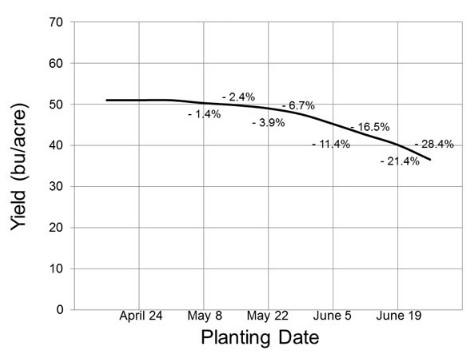If misery loves company, when it comes to corn and soybean planting there is plenty of love throughout the Midwest. Almost continually wet weather means wet soils and that means that days suitable for planting are few and far between. May rainfall totals in parts of Missouri are over 10 inches with rain in the forecast for much of the next week. Somehow, Missouri farmers have planted 62% of their intended corn acres according to NASS information published on May 20. That's less than Iowa, but much more than states along the Ohio River (figure 1A). Only 24, 14, and 9% of the corn has been planted in Illinois, Indiana, and Ohio. Although 62% is not terrible, that is 30 percentage units less than the 5-year average of 92%. The misery is deeper in several states. Corn planting progress is 65, 59, and 53 percentage units behind the 5-year averages for Illinois, Indiana, and Ohio (figure 1B). Based on March planting intensions, more than 40 million acres of corn remain to be planted in 11 Midwest states.
Figure 1 A) Corn planting progress (% of intended) in 2019. B) Corn planting progress (% of intended) in 2019 Compared to 5-year average.
About 71% of the planted Missouri corn has emerged. Unfortunately, NASS estimates that 65% of the emerged corn is in fair or worse condition. Unfortunately, many corn enemies including the fungi that cause seedling diseases thrive in wet, cool soils. Please read Greg Luce's excellent article that offers advice on farmers considering replanting corn (
https://ipm.missouri.edu/IPCM/2019/5/evaluatingCornStands/). A summary statement from his article might be that a moderately poor corn stand e.g. 16,000 plants/acre from a May 1 planting may have the same or greater yield potential than an excellent stand from a May 31 planting.
Delayed corn planting pushes back soybean planting. Only 9% of Missouri's intended soybean acreage has been planted according to NASS. That is 29 percentage units behind our 5-year average of 38%. Midwestern states with slow corn planting progress also have slow soybean planting. For example, Ohio farmers have planted only 4% of their intended soybean acreage (figure 2A). That is 31 percentage units behind their 5-year average (figure 2B).
Figure 2 A) Soybean planting progress (% of intended) in 2019. B) Soybean planting progress (% of intended) compared to 5 year average.
Figure 3 Effect of planting date on soybean yield (average of 12 experiments - Columbia, MO.).

Planting date affects soybean yield, although somewhat less than corn yield. Our data indicate that, on average, soybean planted on May 31 has lost 7% of its yield potential (figure 3). Farmers may be considering changing some of the acreage from corn to soybean. That may make sense when considering yield potentials. But, I offer two cautions. Some of those 40 million corn acres will not be planted in 2019. The majority of corn acres that were or will be planted were planted after the optimum date for yield. Fewer acres and decreased yield potential will put upward pressure on corn grain prices. If soybean acreage increases above the 85 million intended, soybean prices may be depressed from their currently poor levels. These potential changes in price and income may tip the balance toward staying with corn. Because of wet harvest conditions last fall, soybean seed quality is poor for many soybean varieties. Seed of high-yielding varieties with good to excellent seed quality is scarce. Farmers switching from corn to soybean may need to accept varieties that are not their first or second choice.
The decision to switch from corn to soybean or stay with corn is one of the more difficult decisions a farmer makes. Partly because we are in a situation where the decision is between two bad alternatives. All of us that love Missouri agriculture have empathy for farmers as they wait for dry weather to return, so they can get back to the parts of farming they love.